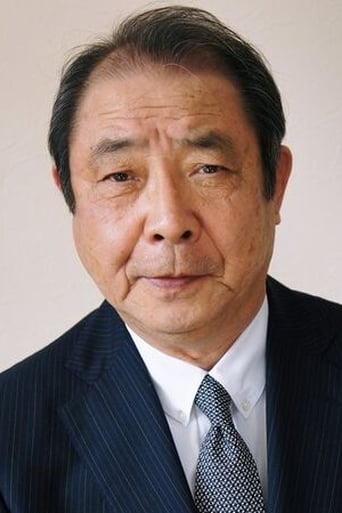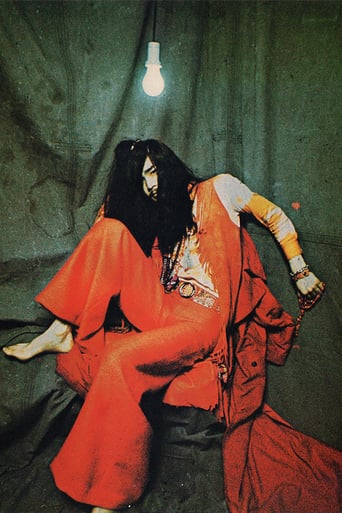Lovesusti
The Worst Film Ever
Wordiezett
So much average
Arianna Moses
Let me be very fair here, this is not the best movie in my opinion. But, this movie is fun, it has purpose and is very enjoyable to watch.
Candida
It is neither dumb nor smart enough to be fun, and spends way too much time with its boring human characters.
uankdeh
On first look, this movie appeared to have everything I desire, but I was let down. My biggest problem was there were too many distractions from the actual story of the movie which resulted in boredom. The beginning and ending of the film serves as a breaker of the fourth wall which, however interesting, doesn't add one iota to the actual plot. Instead, it seems to serve other political intentions/themes for which I was just not interested in. You can research 1970s Japanese subculture both on the streets and in cinema to understand the connections, but even then, unless you're a film buff with this particular regional interest, it doesn't add to the actual story at hand.The second plot detractor, was the incorporation of the random scenes. These included things like street dancing, some guys smoking drugs in public, a stutterer reflecting on his speech, and video recordings of personal ads. I'm all for the collage style, but again, I could not find any connection from these to the actual plot or the setting.The story and the cinematic effects used had so much potential, but I ultimately found myself bored and detached due to all the unnecessary scenes. The director was trying to accomplish more than one mission in this film and the result was that the objectives clashed and eroded each other, mainly the story of our teenage protagonist.
mevmijaumau
Throw Away Your Books, Rally in the Streets is the first experimental feature film by Shuji Terayama, a poet, playwright, avant-garde director who was also an avid boxer (his love of boxing is referenced several times in this movie, for example). It follows a nameless young boy, whom Terayama calls Watashi ("Me"), and whose family is a complete dysfunctional wreck. His sister has an unhealthy relationship with her pet rabbit, his grandma is a shoplifter, and his frustrated father takes "Me" to the whorehouse.The story is completely non-linear, interfused with strange phantasmagorical collages, music videos and surreal imagery. A lot of scenes are colored in nauseating filters of green, red and pink, which are even more annoying in occasional motion sickness-inducing shaky cam scenes. There's also a scene of random people longing to find soul mates and putting a newspaper ad. Another repeated element are "Me"'s day dreams, which see him trying to fly away on a plane, but his hopes of getting somewhere are ruined in the scene where he calls out the country of Japan for a moral decline, and his fiery plane comes crashing down to earth.The message of the film is presented bluntly in its title. Terayama tells the academics that their approach to this film simply isn't needed. A film should be experienced, not analyzed, and people should spend time on the streets instead of spending it at a cinema or reading books (this message would be more understandable if city life were as crazy as a Terayama film). This message is featured everywhere in the film. Quotes from famous thinkers graffiti'd on the walls. An intellectual in a restaurant boring his female companion to death by talking about literature (and later we're given a more entertaining take on books from a local prostitute). The recurring riddle "What goes one way in and two ways out?", which we're lead to believe the answer to is something deep and intellectual, happens to be revealed simply as "a pair of trousers".Terayama also breaks the fourth wall a lot to establish an anti-cinema approach to filmmaking. The movie begins with an uncomfortably long black screen, when suddenly "Me" appears, asking the audience what they're doing sitting in front of a black screen, and then mocks them because they're hidebound in a theatre while he's free to do whatever he wants, like light a cigarette. The ending is about 10 minutes long; in it, the entire crew is gathered in a single shot while "Me" holds a speech about the boundaries of cinema ("Polanski, Nagisa Oshima, Antonioni... All that is just a world that disappears when the light is turned on"). After that, the camera trails the faces of everyone involved with the film in close-up and the film fades to black.I forgot to mention the countless locker room scenes where "Me" and the other boys discuss masturbation techniques and how sports ball sizes are parallel to virility. I guess these scenes are meant to portray "Me"'s frustrations related to masculinity. Later his locker room friends gang rape his sister under the shower and we're subjected to a short musical sequence spoofing Ken Takakura, a famous macho movie star known for yakuza films.Regarding the soundtrack (by Tokyo Kid Brothers and J. A. Seazer, who appears as a long-haired poet), it's awesome. Probably one of the best movie soundtracks I've heard in a while. It's like a mix of nursery rhymes and post-hippie psychedelic rock. It's crazy. One of the musical scenes starts with a burning American flag which reveals a couple having sex and youngsters raising chaos on the streets. After that, a humorous scene where a young girl protests because people took her phallic punching bag off the streets explodes into an angst-ridden, energetic song "Who is it for?" But by far the catchiest and the most radical tune is what I presume is called "Mother", which even borders on Oedipus' complex (another running theme in Terayama's films). The imagery the song is set to is an American comic (the style reminds me of Robert Crumb) where a father has sex with his daughter after he sees her masturbating, after which the mother asks her son if he jerks off. Trying to follow this comic while reading the song lyric-subtitles while trying to enjoy the song is a complete sensory assault and it's hard to find anything similar. Did I mention the short musical interlude that features a group of schoolgirls casually stripping on a farm, singing how they'll become prostitutes?The movie, as I described it, seems completely crazy, fun and incomprehensible, but unfortunately the scenes of true cinematic weirdness are sandwiched between long scenes of dubious importance which border on tedium, and overall the film is largely undeserving of its runtime. I'll give it a higher rating just for the kick-ass soundtrack though.
Iain Cocks
I like to take a chance with the films I watch - sometimes it pays off, other times I wish I'd just skipped over it. This film belongs in the latter category.It really was awful... The characters are abhorrent, the dialogue is nonsensical, the use of green and purple filters is nauseating, It's just a horrendous viewing experience. Not to mention the scenes of gang rape, bestiality and animal cruelty, all accompanied by a cacophony of screams, wails and weird chanting, used simply to shock the viewer and further twist the dystopian society this film presents us with. The worst example of art-house cinema... I advise you to stay clear....The prostitution song was fun though ;)
NateManD
It's difficult to describe this rare film by Terayama. I was lucky enough to track down a rare subtitled version of the film. Although the quality was faded, the film still had me glued to the screen. Trippy color filters and noise rock interludes of Sing along angst ridden protest music. The music sounds like punk rock, but the film was made 6 years before the punk movement broke out. The music of the film had to of had some sort of influence on the punk scene. The film has an unconventional narrative style almost like Gummo. Basic story is about a teen in Japan, who plays soccer and deals with his highly dysfunctional family. His grandma is senile, his sister loves her pet rabbit to the point of sexual obsession, and his father gets him a prostitute so he can be more of a man. Out of rage our protagonist runs away and hits the street. But the main story is broken up by random short narratives of various Japanese strangers, punk like sing alongs and psychedelic surreal imagery. The funniest scene has to be when a young girl and teen guy hang up a penis shaped punching bag in a public side walk area. The Directer Terayama was the founder of Japanese Avant-Garde style theater in Japan, Emperor Tomato Ketchup is his more well known film. This is definitely one of the strangest and best Japanese films ever made!!! 10/10




